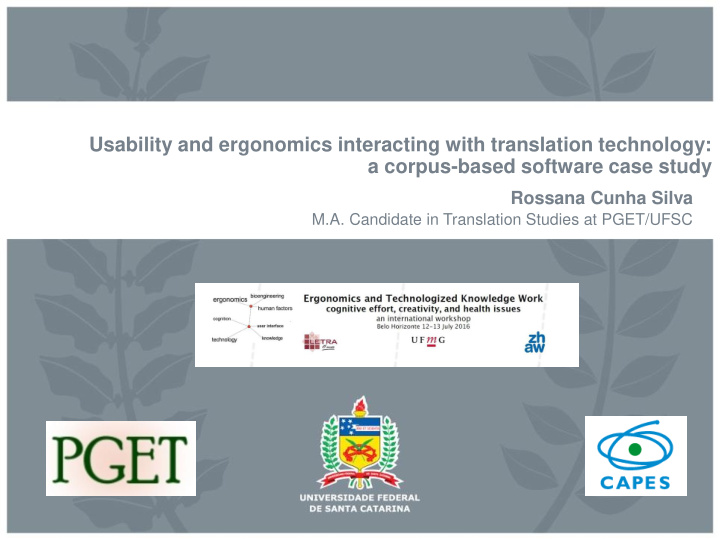



Usability and ergonomics interacting with translation technology: a corpus-based software case study Rossana Cunha Silva M.A. Candidate in Translation Studies at PGET/UFSC
Summary The context; Problem; Objective; Method; Results; Conclusions & expectations.
The context This presentation is part of my Master’s research carried out at UFSC with COPA-TRAD Corpus Analysis System. This software was developed at Universidade Federal de Santa Catarina (UFSC).
Usability & Ergonomics Usability is the capacity in which a product can be used by specific users to achieve specific goals with effectiveness, efficiency and satisfaction in a specific context of use (ISO 9241-11, 2002, p.3). Ergonomics is the study of how humans interact with manmade objects. The goal of ergonomics is to ensure that systems and devices are well-suited to user's physical needs. In that way, Ergonomics provides usability (CYBIS, 2010).
Motivation The continuous development of translation technologies has fundamentally changed the way users of this area interact with computers. The need for understanding and measuring how a vast number of resources and software applications can impact users had led to recommendations related to human-computer interaction (HCI) presented as guidelines and best practices, such as the works of Massey & Ehrensberger- Dow (2011), O’Brien (2012), Ehrensberger-Dow & Massey (2014a, 2014b), Suojanen et al. (2015) etc.
Problem Unfortunately, when developing translation tools limited attention is still paid to usability and ergonomics, be it during the design, implementation or deployment phase. Meanwhile, the level of complexity of corpus-based translation tools has increased in difficulties and diversity, however, this evolution does not take into consideration HCI recommendations yet (CUNHA SILVA, Forthcoming).
Objective The goal of this study is to bridge the gap between corpus-based tools, ergonomics, and usability, by presenting the results of a user- oriented methodology (CUNHA SILVA, Forthcoming).
Method A corpus analysis software, called COPA-TRAD (FERNANDES & SILVA, 2014), was used as the basis for applying some existing methods within usability and ergonomics area. The proposed study was composed of three main stages: (i) usability questionnaire (GRESSE VON WANGENHEIM et al., 2014) – administered to participants of this knowledge area; (ii) heuristics analysis (NIELSEN, 1994) – performed by usability experts; (iii) ergonomics checklist inspection (ERGOLIST, 2011), to analyze general elements.
Method Heuristic evaluation is based on the methodology proposed by Nielsen et al. (1990; NIELSEN, 1994) to validate system characteristics according to ergonomics and usability concepts. Heuristics are usability principles, composed of general rules, or more specifically, ten criteria responsible for validating the features presented on interfaces, for instance: System status visibility; Error prevention; Help and documentation, etc.
Results The results indicated that despite the concern of providing a “user - friendly” interface (FERNANDES & SILVA, 2014), the analyzed system had not made use of known usability and ergonomics methods, just guidelines of the third-party software used as part of COPA- TRAD (i.e., Bootstrap, Agile methodologies etc.).
Usability questionnaire Image 1 – User-centered approach Image 2 – Questionnaire results. (ARRIZZA, 2014)
Heuristics Analysis Image 3 – Heuristics evaluation results – Adapted from Arrizza (2014).
Ergonomics Inspection Checklist Image 4 – ErgoList (2011) results.
Conclusions and expectations The study points out directions on which a corpus- based tool can be adapted to user needs and further indicate some important criteria that require improvement. We believe translation technology should also include the concern with building adequate interfaces, allowing humans to interact effectively with tools data and facilitating the process of retrieving information.
References Arrizza, Elida (2014, September) 10 Golden Heuristics of Usability. Presentation at WordCamp Ottawa 2014, Montreal, OTT. Retrieved from: http://pt.slideshare.net/elida-arrizza/the-10-golden-usability-heuristics-montreal-girl-geeks-september-2014 Cunha Silva, R. (2016) Avaliação de um sistema com base em corpus para a pesquisa, ensino e prática da tradução sob as perspectivas da ergonomia e usabilidade [Evaluation of a corpus-based system for research, teaching, and practice of translation, from ergonomics and usability perspectives]. (Unpublished Master's Thesis). Universidade Federal de Santa Catarina, Florianópolis. Cybis, W. A.; Betiol, A. H.; Faust, R. (2010) Ergonomia e usabilidade: conhecimentos, métodos e aplicações [Ergonomics and usability: knowledge, methods and applications]. Novatec. Ehrensberger-Dow, M., & Massey, G. (2014a). Cognitive ergonomic issues in professional translation. The development of translation competence: Theories and methodologies from psycholinguistics and cognitive science, 58-86. ____________.(2014b). Translators and machines: Working together. Man vs. Machine, 1, 199-207. ErgoList (2011). Retrieved from http://www.labiutil.inf.ufsc.br/ergolist/ Fernandes, L. P.; Silva, C. E. (2014). COPA-TRAD (Corpus Paralelo de Tradução) [Translation Parallel Corpus). Universidade Federal de Santa Catarina, Florianópolis, 2014. Retrieved from: http://copa-trad.ufsc.br Gresse von Wangenheim, C., Borgatto, F., Oliveira, R. J. D., Krone, C., Reolon, M., & Xafranski, J. (2014) Sure: uma proposta de questionário e escala para avaliar a usabilidade de aplicações para smartphones pós-teste de usabilidade [Sure: a questionnaire and scale proposal to evaluate the usability of applications for smartphones after usability post-testing]: Conference Interaction South America, Buenos Aires, Argentina. Retrieved from: http://bibliotecadigital.uca.edu.ar/ponencias/sure-proposta-questionario-escala.pdf Massey, G., & Ehrensberger- Dow, M. (2011). Technical and instrumental competence in the translator’s workplace: Using process research to identify educational and ergonomic needs. ILCEA. Revue de l’Institut des langues et cultures d'Europe, Amérique, Afrique, Asie et Australie, (14). Nielsen, J. (1994). Heuristic evaluation. Usability inspection methods, 17(1), 25-62. Suojanen, T., Koskinen, K., & Tuominen, T. (2014). User-centered translation. Routledge.
Thanks! Rossana Cunha Silva E-mail: rossanacs@gmail.com https://ufsc.academia.edu/RossanaCunha https://www.researchgate.net/profile/Rossana_Cunha
Recommend
More recommend